Two Forests
Kielder Forest, Northumberland, England
A silent thankfulness accompanied my footsteps, for the creation of this enormous forest, the trails, signage and the shelters, for nature and people coming together to create this arcadia of soul-expanding beauty.
In the post-war era of 1932, the British forestry department had a blazing good idea to plant a massive working forest in a cold, boggy, uninhabited part of northern England, so that there would be plenty of wood for harvest in the future for lining trenches, building ships, railway sleepers and homes. It would also save the old growth forests.
They got going, and today, a 650-square-kilometre area, dense with 150 million trees, sprawls across the landscape in Northumberland. Fifty lorries stashed with trunks are extracted daily (behind the scenes) and saplings are planted. Sitka spruce trees were sourced from Alaska for their impressive height and girth and native species such as oak, rowan and birch were planted alongside.
And while on the one hand Kielder is enjoyed as a recreational arena for hiking, biking, swimming and staying in beautifully designed glass houses and wooden cabins, coming here, there is a sense of pride in the planning and payoff of silviculture.
Just after breakfast, my friend Emily and I left the cosy Pheasant Inn and took a ride to Kielder Dam, from where we followed the Lakeside Way trail back through the woods. Every now and then, as the land rose and fell, we had views of Kielder Water, Europe’s largest manmade lake at the heart of the forest.
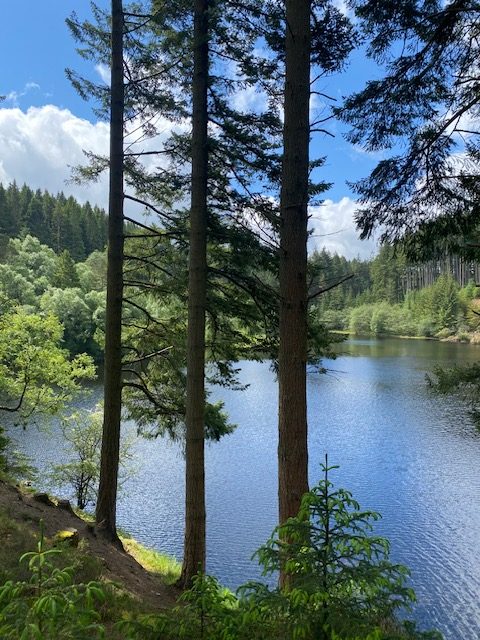
Photo: Geetika Jain.
The oval trail around the lake is 27 miles long and we chose to walk each side over two days, lingering at the viewpoints and exploring the art installations along the way.
Treading on soft pine needles on the second day, we kept a steady pace, consulting the map every now and then. On either side were standing armies of soaring, ramrod trees. Dense green moss blanketed the ground, stretching over fallen logs and stubs.
An old Chinese proverb rang true: ‘The crooked trees get to live their lives, but the straight ones become planks.’ These trees were left to mature over 30-40 years before they served as pine wood.
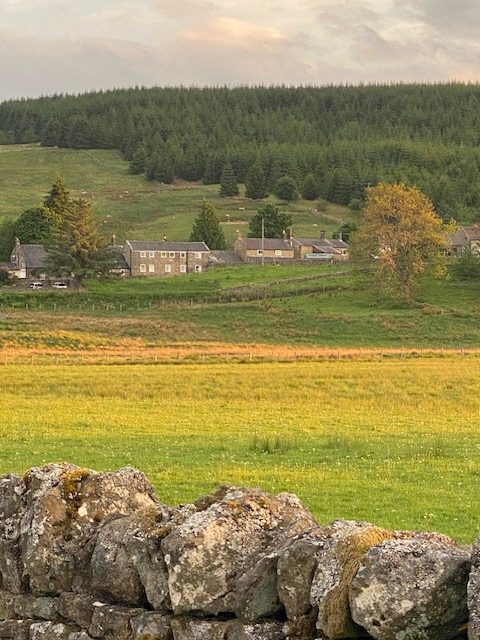
Photo: Geetika Jain.
Walking in the vast forest felt safe and liberating, and the road ahead was mostly empty. We went on for hours, enjoying each other’s company, talking our hearts out and pushing our bodies over eight hours – with a pause for a delectable lunch at a cafe – till our muscles winced. We flopped on mossy logs for breaks and took-in the silence. It felt deep-down good.
We held the delicate buttercups between our fingers, were pricked by yellow gorse and brushed against hawthorn trees in bloom. And while there was birdsong in the air, and we saw the odd scampering hare and the ducks on the lake, something was missing; the frisson of glimpsing wild creatures or even the prospect of coming across one. There is talk of releasing wild lynxes in these parts, for there were native here, as were wolves, but the sheep farmers are yet to be convinced.
But we did have wild skies. Kielder Forest is a dark-sky preserve with a trick up its sleeve – an observatory where one can peer at galaxies millions of light years away. And even though we did not have tickets, Dan Monk, who runs it, shared a location where we sat back on a grassy bank at midnight and enjoyed the splendour of the jewelled sky.
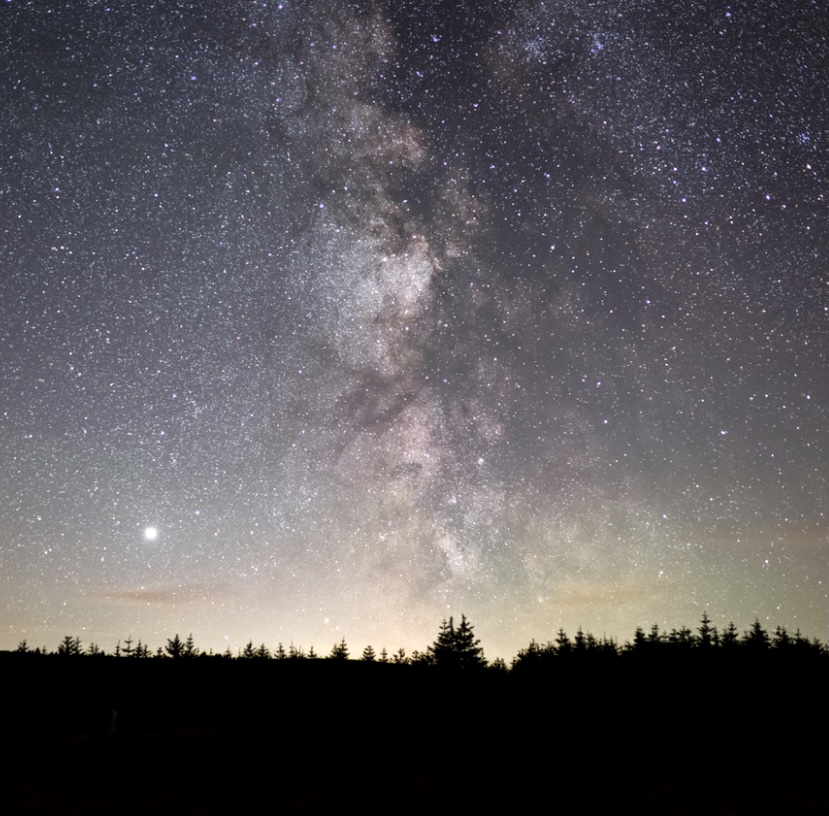
Photo: Dan Monk.
§
Pench National Park, Madhya Pradesh, India
There’s nothing like that early morning blush in the sky and a heart full of anticipation as the jeep enters a forest. Past Karmajhiri Gate at Pench National Park, in late March, the teak forest had shed its large rust leaves, and they lay crumpled on the ground. Camel foot creepers curled above them like scribbles in the air. Ghost trees with their naked white bark stood out in the forest like silent sentinels, their limbs reaching out eerily. That distinct scent was the mahua fruiting.
In the gently undulating landscape, the road curved around the hills, and a handful of enormous gaurs came into view, castling around their young. Three Malabar pied hornbills with outsized yellow beaks floated past us to land on a crocodile-bark tree. A golden-backed woodpecker knocked away at a trunk.
As the sun came out and the day warmed rapidly, shiny black turtles clambered over a log in the pond. Brahminy ducks and woolly-necked storks went about their business, poking for fish. A male peacock displayed with elan, shimmying his behind, but the peahens walked away, looking terribly bored. It made us laugh. My binoculars were getting heavy.
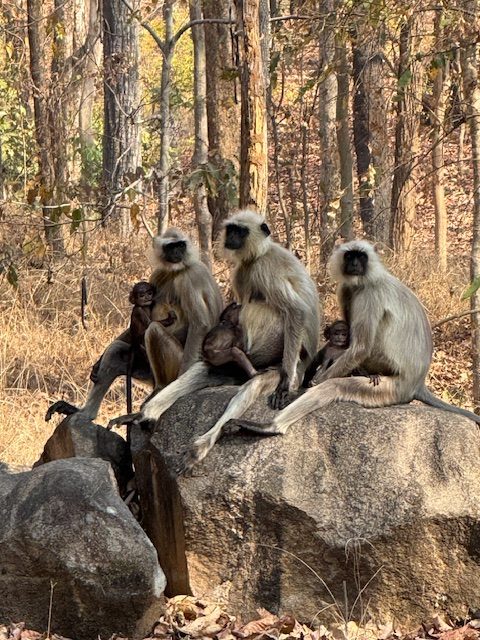
Langurs at Pench. Photo: Geetika Jain.
Much as I longed to roam these forests on foot, to take a closer look at the red kumkum leaf, to try the mahua or to have the place to myself for just a few moments, that’s not an option here.
A scrum of jeeps ahead…a leopard had been spotted, and we followed it as it moved through the leafy thickets, the langurs alarming hysterically long after it disappeared.
Our driver received some intel over his mobile and we found ourselves tearing towards Bodhanala, where a tigress had been spotted. Barely visible at first, she emerged from the tall grass and walked towards us. At that moment, I felt what the Inuit call ilira, the fear that accompanies awe upon seeing a polar bear. It pierced through me as our eyes locked for a second.
The next moment, we watched our tigress turn and stalk a chital, silently, minimising herself, one paw raised and held after another, until she suddenly exploded after it and then gave up after a short chase.
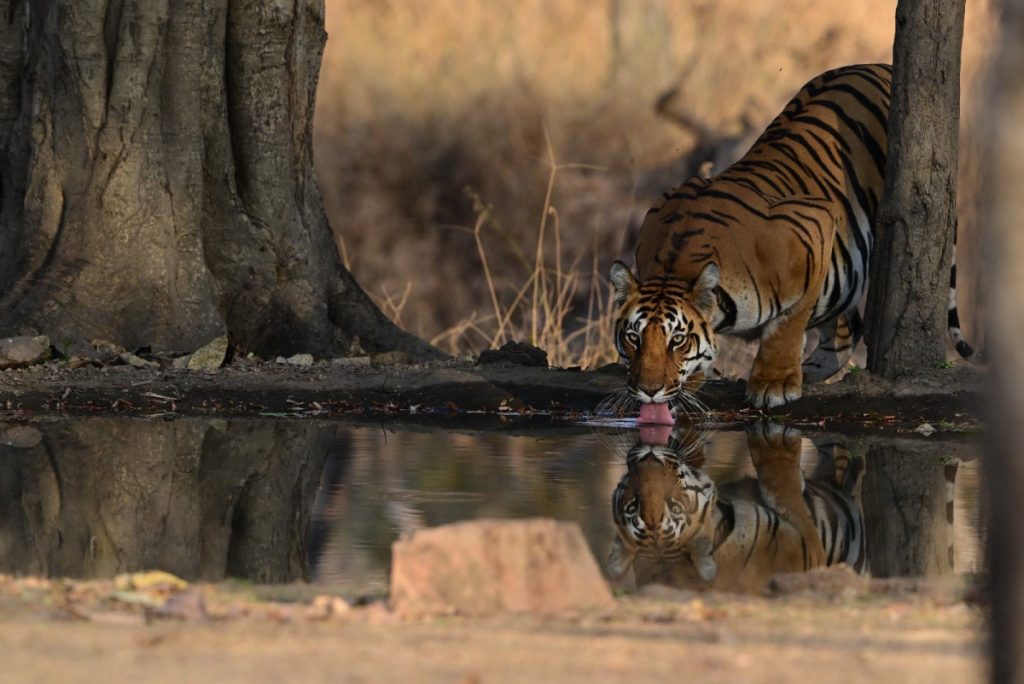
The tigress. Photo: Shumeet Banerji.
She turned to a small pond right by us and lapped for ages before turning around and lowering her ‘fearful symmetry’ into it. Ahhh. She must feel pleasantly cool. It was a moment to remember and hold close.
There are surprisingly few countries on our planet where one can criss-cross a vast and varied terrain in the comfort of a jeep, whilst seeing innumerable species and charismatic megafauna. It really is something to be thankful for.
I noticed how superbly the Pench forest was managed. Solar pumps ensured plentiful waterbodies all over, the fire lines were assiduously maintained, visitors can only buy food or have their picnic at a designated stop at Allicutta, which keeps the forest pristine. Many locals have been trained as drivers and guides and they were particular about the timings of the exits.
Having to exit can be a bit of a drag, especially if you’re on to something. It’s like leaving a movie halfway…but then I remind myself these reserves are rare and intact ecosystems, best allowed some respite without jeeps and people.
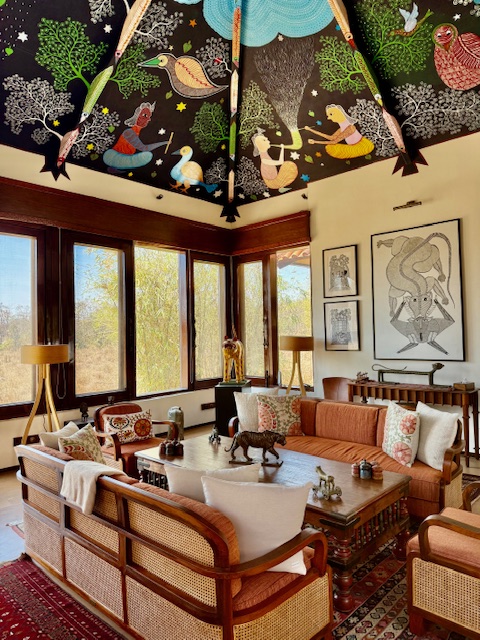
Photo: Geetika Jain.
Back at Haldu Tola, the beautiful villa where our friends hosted us, we dined that night on their roof terrace. The buffer forest was right around us and its obsidian blackness was rent every now and then with the other-worldly calls of rutting chital stags.
And then, they switched off all the lights and what a show the sky had put up. There was the North Star, and Orion’s belt and the Big Dipper. Just like Kielder Forest. And here I was, in a completely different world, linked inexorably by those familiar stars.
Geetika Jain can be followed on Instagram @geetikaforest.
§
Ways and means
Kielder Forest, Northumberland
We took the Northern Rail from Kings Cross (London) to Newcastle (three hours); Ronny’s taxi service drove us an hour (+44 077 114 00152) to the ultra-charming Pheasant Inn (01434240) in Falstone, where we enjoyed delicious fare and stayed two nights.
Best time for Kielder is May-October. For sky viewing at the observatory, moonless nights in August and September are ideal.
Pench National Park, Madhya Pradesh
We flew to Jabalpur (Nagpur is just as good). A car service drove us to Pench (four hours) where we stayed at Haldu Tola, a four-room villa (adjacent to Jamtara Wilderness Camp).
Best time to go: September to May. The best time for viewing tigers is March-April, when the foliage is down and the visibility is good.
This article went live on May seventeenth, two thousand twenty five, at thirty minutes past seven in the evening.The Wire is now on WhatsApp. Follow our channel for sharp analysis and opinions on the latest developments.




